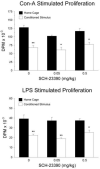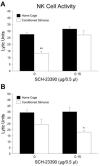Neuroimmune mechanisms of opioid-mediated conditioned immunomodulation
- PMID: 17689049
- PMCID: PMC4031923
- DOI: 10.1016/j.bbi.2007.06.009
Neuroimmune mechanisms of opioid-mediated conditioned immunomodulation
Abstract
Morphine administration elicits pronounced effects on the immune system, including decreases in natural killer (NK) cell activity and lymphocyte mitogenic responsiveness. These immune alterations can become conditioned to environmental stimuli that predict morphine as a result of Pavlovian conditioning processes. Prior work in our laboratory has shown that acute morphine exposure produces dopamine-dependent reductions of NK cell activity that are mediated peripherally by neuropeptide Y Y1 receptors. The present study examined the involvement of dopamine D1 and neuropeptide Y Y1 receptors in the conditioned immunomodulatory effects of morphine. Rats received two conditioning sessions during which an injection of morphine was paired with a distinctive environment which served as the conditioned stimulus (CS). The results show that systemic administration of the D1 antagonist SCH-23390 prior to CS re-exposure prevented the conditioned suppression of splenic NK activity but did not alter conditioned decreases in mitogen-induced lymphocyte proliferation. Furthermore, bilateral microinjections of SCH-23390 directly into the nucleus accumbens shell fully blocked conditioned changes in NK activity. In a subsequent manipulation, subcutaneous injection of the Y1 receptor antagonist BIBP3226 prior to CS re-exposure was also shown to prevent conditioned effects on NK activity. Collectively, these findings provide evidence that the nucleus accumbens shell plays an important role in conditioned immunomodulation and further suggest that the conditioned and unconditioned immunomodulatory effects of opioids involve similar receptor mechanisms.
Figures




Similar articles
-
Neuropeptide Y Y1 receptors mediate morphine-induced reductions of natural killer cell activity.J Neuroimmunol. 2006 Aug;177(1-2):18-26. doi: 10.1016/j.jneuroim.2006.05.002. J Neuroimmunol. 2006. PMID: 16766046
-
Suppression of natural killer cell activity by morphine is mediated by the nucleus accumbens shell.J Neuroimmunol. 2006 Apr;173(1-2):3-11. doi: 10.1016/j.jneuroim.2005.11.009. Epub 2005 Dec 20. J Neuroimmunol. 2006. PMID: 16364456
-
Evidence for the nucleus accumbens as a neural substrate of heroin-induced immune alterations.J Pharmacol Exp Ther. 2009 Jun;329(3):1040-7. doi: 10.1124/jpet.108.148627. Epub 2009 Mar 3. J Pharmacol Exp Ther. 2009. PMID: 19258519 Free PMC article.
-
Pavlovian conditioning of morphine-induced alterations of immune status: evidence for peripheral beta-adrenergic receptor involvement.Brain Behav Immun. 1994 Sep;8(3):204-17. doi: 10.1006/brbi.1994.1019. Brain Behav Immun. 1994. PMID: 7865892
-
Pavlovian conditioning of morphine-induced alterations of immune status: evidence for opioid receptor involvement.J Neuroimmunol. 1994 Dec;55(2):135-42. doi: 10.1016/0165-5728(94)90003-5. J Neuroimmunol. 1994. PMID: 7829663
Cited by
-
Female rats express heroin-induced and -conditioned suppression of peripheral nitric oxide production in response to endotoxin challenge.Brain Behav Immun. 2021 Jan;91:315-323. doi: 10.1016/j.bbi.2020.10.009. Epub 2020 Oct 8. Brain Behav Immun. 2021. PMID: 33039661 Free PMC article.
-
Effects of fentanyl anesthesia and sufentanil anesthesia on regulatory T cells frequencies.Int J Clin Exp Pathol. 2014 Oct 15;7(11):7708-16. eCollection 2014. Int J Clin Exp Pathol. 2014. PMID: 25550807 Free PMC article.
-
Region-specific contribution of the ventral tegmental area to heroin-induced conditioned immunomodulation.Brain Behav Immun. 2014 May;38:118-24. doi: 10.1016/j.bbi.2014.01.008. Epub 2014 Jan 24. Brain Behav Immun. 2014. PMID: 24462948 Free PMC article.
-
Effects of neonatal stress and morphine on kappa opioid receptor signaling.Neonatology. 2009;96(4):235-43. doi: 10.1159/000220763. Epub 2009 May 27. Neonatology. 2009. PMID: 19478529 Free PMC article.
-
Intensive Care Unit-acquired infection as a side effect of sedation.Crit Care. 2010;14(2):R30. doi: 10.1186/cc8907. Epub 2010 Mar 15. Crit Care. 2010. PMID: 20226064 Free PMC article. Review.
References
-
- Ader R, Cohen N. Behaviorally conditioned immunosuppression. Psychosom. Med. 1975;37:333–340. - PubMed
-
- Ader R, Cohen N. Behaviorally conditioned immunosuppression and murine systemic lupus erythematosus. Science. 1982;215:1534–1536. - PubMed
-
- Ader R, Cohen N. Conditioning and immunity. In: Ader R, Felten DL, Cohen N, editors. Psychoneuroimmunology. Academic Press; San Diego: 2001. pp. 3–34.
-
- Ader R, Cohen N, Grota LJ. Adrenal involvement in conditioned immunosuppression. Int. J. Immunopharmacol. 1979;1:141–145. - PubMed
-
- Bedoui S, Lechner S, Gebhardt T, Nave H, Beck-Sickinger AG, Straub RH, Pabst R, von HS. NPY modulates epinephrine-induced leukocytosis via Y-1 and Y-5 receptor activation in vivo: sympathetic co-transmission during leukocyte mobilization. J. Neuroimmunol. 2002;132:25–33. - PubMed
Publication types
MeSH terms
Substances
Grants and funding
LinkOut - more resources
Full Text Sources
Other Literature Sources
Medical
Research Materials
Miscellaneous

